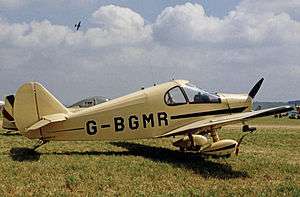CAB Minicab
The CAB GY-20 Minicab is a two-seat light aircraft built in France in the years immediately following World War II.
| GY-20 Minicab | |
|---|---|
 | |
| GY-201 Amateur-built in the UK | |
| Role | light aircraft |
| Manufacturer | Constructions Aéronautiques du Béarn |
| Designer | Yves Gardan |
| First flight | 1 February 1949 |
| Number built | 30 + ca. 130 homebuilt |
Design and development
It is a conventional, low-wing cantilever monoplane with fixed tailwheel undercarriage. Its design was a scaled-down version of the aircraft that Yves Gardan had designed for SIPA, the SIPA S.90. The pilot and passenger sit side by side and access to the cockpit is via a one-piece perspex canopy that hinges forwards. Gardan's intention was to produce a low-cost, easy-to-fly, easy-to-maintain aircraft with the possibility of homebuilding.[1][2]
Production
The prototype Minicab first flew at Pau-Idron on 1 February 1949 with Max Fischl at the controls. CAB manufactured a total of 22 Minicabs. This was followed by a larger number completed by amateur builders in France and other countries around the world. Several Minicabs currently active in the United Kingdom have been rebuilt to the JB.01 standard developed by M. Jean Barritault. Falconar sold plans for a tricycle gear homebuilt model named the Minihawk.[3]
Operational history

Type certification was obtained in mid-April 1949. By the end of 1950, a Minicab had won the Coupe de Vitesse de Deauville (Deauville Cup for speed), and the Grand Prix Aérien de Vichy (Vichy Aerial Prize). The following year, a Minicab broke the world air distance record for its class (1,825 km, 1,138 miles) and in 1952 it attained the world airspeed record for its class over a 2,000 km circuit, with an average speed of (183 km/h, 114 mph).
Variants
- GY-20 Minicab
- production model.
- GY-201 Minicab
- refined version with strengthened undercarriage, split flaps, and castering tailwheel.
- Falconar Hawk
- Minicabs built to plans supplied by Falconar
- Falconar MiniHawk
- plans-built design from Falconar with tricycle undercarriage.
- Barritault JB.01
- Minicabs rebuilt to the designs of Jean Barritault.
Specifications (GY-20)
Data from Jane's All The World's Aircraft 1956–57[4]
General characteristics
- Crew: two
- Length: 5.45 m (17 ft 11 in)
- Wingspan: 8.14 m (26 ft 8 in)
- Height: 1.65 m (5 ft 5 in)
- Wing area: 10.15 m2 (109.3 sq ft)
- Empty weight: 270 kg (595 lb)
- Gross weight: 485 kg (1,069 lb)
- Fuel capacity: 50 L (11 imp gal; 13 US gal)
- Powerplant: 1 × Continental A65 four-cylinder air-cooled horizontally-opposed piston engine, 48 kW (65 hp)
- Propellers: 2-bladed Merville wooden, 1.64 m (5 ft 5 in) diameter
Performance
- Maximum speed: 180 km/h (110 mph, 97 kn)
- Cruise speed: 170 km/h (110 mph, 92 kn)
- Service ceiling: 4,000 m (13,000 ft)
- Rate of climb: 3.0 m/s (590 ft/min)
- Take-off run to 20 m (66 ft): 370 m (1,210 ft)
- Landing run from 20 m (66 ft): 343 m (1,125 ft)
References
- Air Trails: 78. Winter 1971. Missing or empty
|title=(help) - Sport Aviation: 23. November 1969. Missing or empty
|title=(help) - "Falconar Plans". Retrieved 2 September 2013.
- Bridgman 1956, pp. 132–133.
- Bridgman, Leonard (1956). Jane's All The World's Aircraft 1956–57. New York: The McGraw-Hill Book Company.
- Simpson, R. W. (1995). Airlife's General Aviation. Shrewsbury: Airlife Publishing. p. 409.
- Taylor, Michael J. H. (1989). Jane's Encyclopedia of Aviation. London: Studio Editions. p. 123.
- aviafrance.com
- Oldtimer-Homepage der Segel- und Motorfluggruppe Veterano, Birrfeld
- Musée Régional de l'Air d'Angers-Marcé
- The Rochester GYAT Flying Group
| Wikimedia Commons has media related to Gardan GY-20 Minicab. |